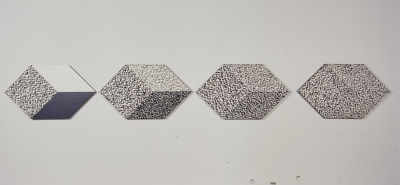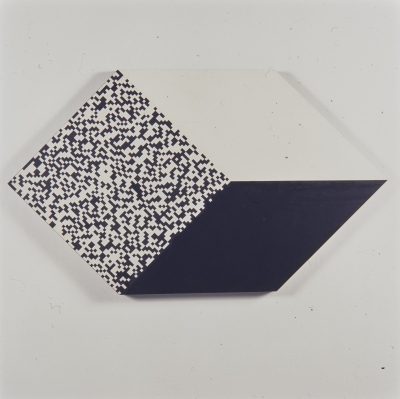Ryszard Winiarski
Statistical Set ABCD. Random Variable – Dice
Statistical Set ABCD. Random Variable – Dice by Ryszard Winiarski is a painting created according to a scientific concept that Winiarski termed as visual presentation of statistical layouts. He used his own program and a game of chance to create these four hexagonal images. The surface of the painting was divided into three sections in the shape of large rhombi and each of them again into smaller rhombi, which, according to the throw of the dice, were assigned specific numbers from 1 to 6. Each of the rhombi used a different system of assigning black or white to specific numbers. In each painting there are three large rhombi with the same result of the throw of the dice but with a different visual presentation system. This allows the viewer to see how the same random pattern is represented in a different way depending on the coding system. Thus, the paintings were the result of a combination of programming and chance, which became the hallmark of Winiarski’s work. According to the artist, all these measures were a method that allowed visualizing the basic order of the world, which was governed by chance rather than planning. Winiarski’s paintings are in fact objective records of the basic structure of random events.
Ryszard Winiarski was a painter, creator of spatial forms and set designer. He studied at the Faculty of Precision Mechanics of the Warsaw University of Technology and at the Faculty of Painting of the Academy of Fine Arts in Warsaw, where he was later vice-chancellor. Studies at the polytechnic and scientific interests influenced the nature of his art. Winiarski offered a concept of art based on the theory of probability, which was very progressive for those times. He tried to use selected sciences issues, for example statistics or game theory, to develop the language of art. The artist’s aim was to create works independent of his own emotions.




